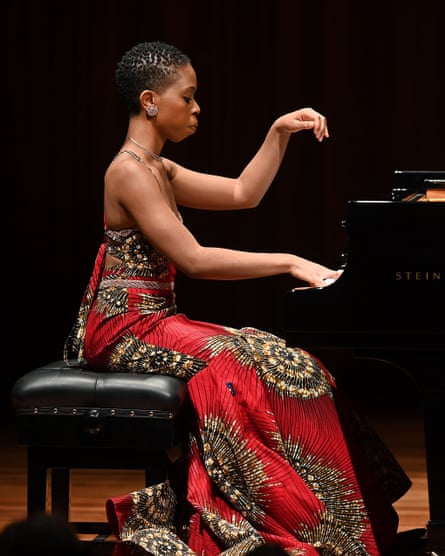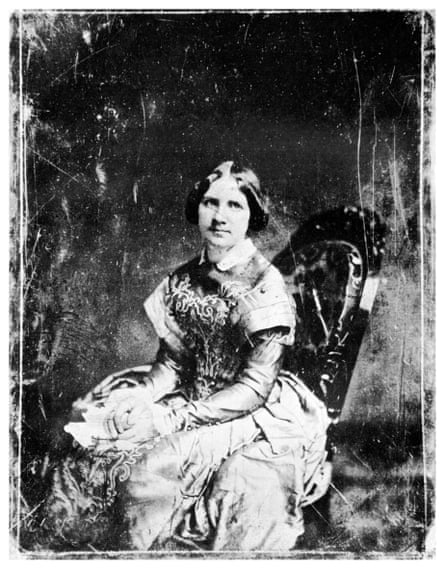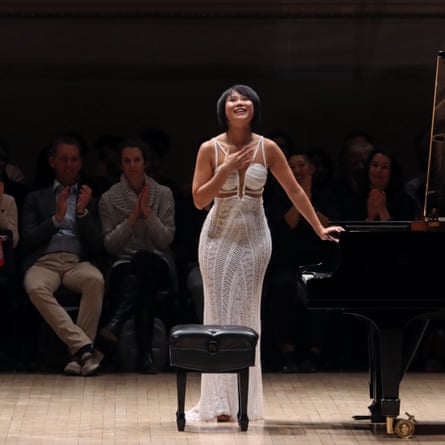Last November, pianist and scholar Dr Samantha Ege gave a recital of works by Florence Price, Margaret Bonds, and Vítězslava Kaprálová at Milton Court Concert Hall. It’s music that’s rarely heard on UK stages, and critics welcomed “the emotional pull to these works” while Ege was praised for her “finely honed performances born of deep study and analysis.
What none mentioned, though, was Ege’s outfit. She was radiant in what she described to me as “a muted red fishtail dress, influenced by west African styles.” The bodice was nipped in at the waist with a customised appliqué belt that glimmered under the spotlights, emphasising hints of silver in the large ammonite-like swirls covering the fabric.

For Ege, as for many other soloists, her outfits are an important part of her performance. “It gives me even more of an opportunity to express myself”, she says. “I think about colours and moods, and how those will make me and the audience feel.” Her dress, designed by M.A.DKollection, was specifically chosen for this Barbican programme. “Antiquity and modernity … converge in the design, which strongly speaks to the themes in my research and repertoire. I champion piano music from the Black Renaissance, an era that reflected themes of cultural rebirth while paying homage to the past, but with an Afrocentric twist. That very much sums up my relationship to concert attire!”
Saxophonist Jess Gillam also has a distinctive concert style, dominated by metallics, striking colour combinations and bold prints. “I love to try and bring a sense of joy to an audience,” Gillam says. “What I am wearing as the performer is part of that.” She picks outfits she feels comfortable and confident wearing. “Most of the music I play is about expressing an emotion or narrative written by somebody else … a level of authenticity is needed to achieve that connection.”
Discussing clothing is something of a taboo in classical music, for performers as much as critics. “Most musicians don’t feel like they can talk about it”, says Jocelyn Lightfoot, managing director of the London Chamber Orchestra. Concert dress is contentious for a host of overlapping reasons. There is the entrenched idea that classical musicians are supposed to be heard and not seen – as the 19th-century critic ETA Hoffmann put it: “The genuine artist lives only for the work … He does not make his personality count in any way.” In this performance ideal, the performer’s personality – expressed through his or her choice of clothing – is excised, deferring to “the music itself”.
Those musicians who step outside the norm in their clothing choices have, accordingly, been subject to severe criticism – especially when they make any kind of crossover into pop, prompting complaints about “dumbing down”. But at least part of the controversy surrounding artists like violinist Nigel Kennedy, with his jeans and spiky hair, is that they remind us that live music is a visual medium. We don’t just hear – we see musicians performing.

For women, the stakes of their clothing choices are considerably higher because women are more frequently sexualised than their male counterparts. While Kennedy’s informal clothes were criticised by some as “ludicrous”, the furore around pianist Yuja Wang betrays this double standard. As much ink has been spilt over Wang’s hemlines as her playing – and with a couple of exceptions, commentary has focused on how “short and tight” her dresses are.
The problem isn’t that critics are talking about Wang’s clothes. It’s that by viewing everything she wears through a sexualised lens, they’re presenting her as a sexual object first and an artist second. There is no room in this worldview for women’s clothes to be both an artistic and personal choice.
Perhaps part of the issue is that fashion lies outside the traditional classical critic’s toolkit. “That’s right, I’ve turned into a fashion critic,” wrote Norman Lebrecht, who described Wang’s outfit as “a micro-dress cut an inch below the butt.” But this sexualised account couldn’t be further from fashion criticism. It tells us nothing about the dress beyond its length. What were the fabrics? Style? Who was the designer? How did the dress choice interact with the musical programme? The language and skills to address these questions might need to become part of the modern critic’s toolkit – and if critics start taking fashion seriously, agents might be able to include outfit details in press releases without fear that it will open the floodgates to derogatory commentary about the artists they represent.
The inability to talk about Wang’s clothing in a sensitive and respectful way reveals damaging and longstanding assumptions around women and their dress on the classical stage. The notion that what we see might “distract from” music, rather than shape our experience of it, stems from a centuries-old division of body and mind, physicality and rationality, that claims classical music as purely cerebral stuff. The body has no place here. And this idea is gendered. Rationality and the mind have historically been coded masculine, sensuality and the body feminine, with the result that women and their bodies have been marginalised within classical music. It’s no coincidence that Hoffmann used “he” as the default for his imagined musician.

This policing of women, their clothes and their bodies in the concert hall is nothing new. When the composer and conductor Ruth Gipps turned up to a concert in 1944 wearing a brightly coloured evening dress, she was roundly chastised for it and informed by the orchestral management: “We don’t care for that sort of self-advertisement.” Gipps was first astonished, and then furious. “What sort of place was this,” she asked, “that expected a woman to be ashamed to wear a beautiful dress?”
It’s a good question. This narrative needs to change, not least because either sexualising or ignoring women’s clothing diminishes their agency as artists. Wang’s clothing has been dismissed as a triviality, an unconsidered marketing ploy with dresses picked purely for whether or not they “show more leg”. And to do so, Wang has been painted as a naive, lost individual who has “had neither time nor guidance to acquire perspective”, and is consequently being used “as tinsel” by more experienced, expert (male) musicians.
The denial of Wang’s agency also feeds into racist stereotypes around the submissiveness and inexpressiveness of both women and classical musicians of Asian descent – stereotypes that Wang’s clothing choices actively disrupt. Wang is one of the most important classical artists performing today, but infantilising performing women is an age-old strategy for diminishing their status and individuality, containing and reducing their potential authority. The 19th-century soprano Jenny Lind, for example, was frequently described as “childlike”. These descriptions are often uncomfortably sexualised, the implication being that such women need some older, stronger man to guide them.

We need to find ways of talking about women’s clothes that respect them as artistic choices, and integral to performance. Dress is becoming more important as questions around diversity and inclusion are pushed to the forefront of institutions’ agendas. The London Chamber Orchestra, for example, has recently removed the dress code for its players. Dispensing with the heavily gendered expectations of black tie is partly, Lightfoot says, to celebrate the individuality of the orchestra’s players and build an inclusive space for musicians whose “way of expressing themselves physically doesn’t fit with that classical music stereotype”. But it’s also to create a “mirror between the audience and orchestra”, reaching out to those “who don’t feel welcome in a concert hall”.
Moreover, social media has made classical music “so much more visual” says Maxine Kwok, a violinist in the London Symphony Orchestra. Orchestras and soloists alike are now attuned to the branding possibilities it offers, from sharing clips of concerts to photographs of rehearsals in jeans and jumpers. And this can, perhaps, be a way of making musicians more accessible. “There’s always a need to modernise,” and using social media “adds a real human element”, Kwok points out, allowing audiences to engage with the musicians they see and hear on the stage.
Musicians are more than the music they create. We evaluate the creative and intellectual decisions that go in to programming – why not clothing as well? Nineteenth-century ideas about what classical music is, who it is by, for and about have all been upended. So, too, must ideas about how it looks.

Comments (…)
Sign in or create your Guardian account to join the discussion